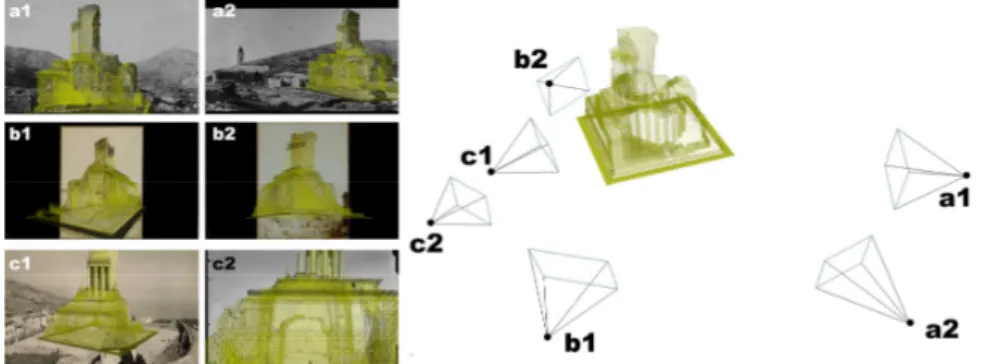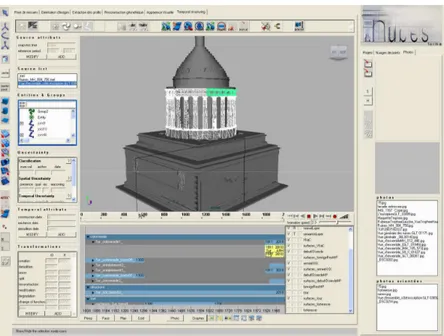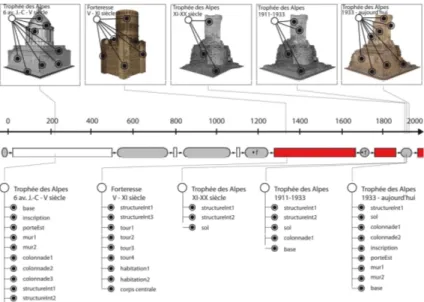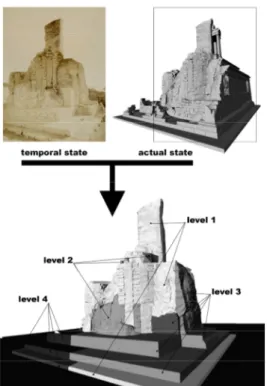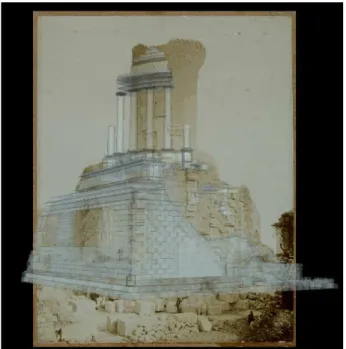This is an author-deposited version published in: https://sam.ensam.eu Handle ID: .http://hdl.handle.net/10985/9807
To cite this version :
Chiara STEFANI, Livio DE LUCA, Philippe VERON, M FLORENZANO - A Tool for the 3D Spatio-Temporal Structuring of Historic Building Reconstructions - In: Proceedings of DMACH 2011: Digital Media and its Applications in Cultural Heritage, Jordanie, 2011 - Proceedings of DMACH 2011: Digital Media and its Applications in Cultural Heritage - 2011
Any correspondence concerning this service should be sent to the repository Administrator : archiveouverte@ensam.eu
A Tool for the 3D Spatio-Temporal Structuring
of Historic Building Reconstructions
C. Stefani
1, L. De Luca
1, P. Véron
2, M. Florenzano
11
FRE CNRS/MCC 3315 MAP-Gamsau Laboratory, Marseille, France
2
UMR CNRS 6168 LSIS-IMS Laboratory, Aix-en-Provence, France
Abstract
The difficulty in the description, the analysis and the comprehension of cultural heritage often stands on the fact that buildings undergo numerous changes over time. Three factors condition the knowledge of historical heritage. Firstly, 3D reconstructions of heritage buildings focus normally on existing states and not on the management of historical evolutions. Secondly, if on one side iconographic sources are generally used like visual memory of a building temporal state to be restored graphically, on the other side few works today focus on the use of all metric and visual information contained in sources. At last, iconographic documentation concerning building past states is sometimes contradictory, dubious and incomplete. As a consequence, in 3D reconstructions uncertainties, contradictions and gaps in information should be highlighted.
We present a methodological approach basing on the existing iconographic corpus for the analysis and the 3D management of building transformations. This approach joins three main aspects in a complete workflow. Firstly, it concerns the spatial and temporal referencing of 2D iconographic sources for the 3D reconstruction of disappeared building states. Secondly, it allows the analysis of building transformations by means of a temporal state distribution. Lastly, it uses spatial relations established between 2D iconography and 3D representation for the visual browsing of information based on spatiotemporal criteria. In particular, in this paper we detail the interface developed in order to accomplish multiple related tasks concerning the spatio-temporal structuring of the morphology to be reconstructed.
Keywords: interface, temporal modeling, uncertainty, architectural heritage, historic transformations
1
Introduction
In recent years, researches deal with the representation of 3D objects and the integration of their geometric level with the semantic one. In the domain of system design, this matter has already been realized: the design and manufacturing processes include the creation, representation, analysis, control and simulation of a model throughout all its lifecycle, until the final product enters the market (Döllner, Kellner, & Tegel, 2000; Garbade & Dolezal, 2007; Sun, 2007). In cultural heritage, this goal is consolidated but more difficult to achieve. European Network of Excellence such as EPOCH underline the importance of using computer graphics techniques in order to analyze and display scientific content related to the building history. For many years, in the fields of computer graphics and historical heritage, two disjointed issues have been discussed. On one hand, architecture reconstruction theories focused on how to convert manual/automatic measurements into realistic 3D polygonal models (Remondino, 2003) and how to extract characteristic points for the 3D reconstruction workflow. On the other one, most researches focused on how to recover hypothetical restitutions of past states starting from archaeological finds and the very few sources (Maïm et al., 2007). Nowadays there is a lack of continuity in the description of cultural heritage. Firstly, historical evolutions are reduced to simple representations of fixed states (if known) having a limited lifespan if compared to the real evolution of historic sites. Secondly, building shape is usually not constant in time: it can undergo significant modifications or even disappear. Finally, iconographic documentation on past states is sometimes contradictory, uncertain and incomplete. As a consequence, it is necessary to manage historical evolutions and to highlight uncertainties, contradictions and information lack in 3D restitutions.
For this reason, we propose a methodological approach that firstly enables 3D reconstruction of past states basing on iconography, and secondly, allows the structuring, analysis and managing of building transformations. The article is structured as follows. Section 2 firstly presents an overview of current researches in cultural heritage (dealing in particular with past state modeling techniques and representation of changes) and than describes the difficulties that have arisen. Section 3 details the general approach composed of three main aspects: the reconstruction, structuring and visualization stages. In particular, section 4 details the second step explaining the 3D model space-time structuring and its enrichment in order to export it for other web applications. Finally, section 5 presents the research perspectives and the limits of our approach.
2
Theoretical framework
In the panorama of current researches, two main topics have been investigatedto represent building cultural heritage buildings: the shape reconstruction of states and the description of evolutions.
Concerning shape modeling, most approaches focus on the modeling techniques of existing elements basing on the survey by means of laser scanner and photogrammetry techniques. Some researches study how to convert measurements into 3D polygonal models (Remondino, 2003) or how to extract significant profiles from point clouds (Remondino et al., 2009). Other approaches bases on sets of photographs to extract characteristic points used for the reconstruction (Werner & Zisserman, 2002). In the case of few existing elements, researches are based on the survey data of few remaining finds (by laser scanner and/or photogrammetry techniques) and restitute the missing geometry either by deduction, assuming the artifact shape basing on fragments, or by analogy, inferring shape on the basis of the known similarity with other artifacts (Cariou, 2005; Sideris & Roussou, 2002). However, the 3D reconstruction of missing architectural elements is a huge topic that opens very different modeling panoramas. Artifacts disappearance requires restituting previous states laying on more dated documentary sources such as historical photographs, paintings in perspective, frescoes, or drawings. Flexible solutions based on one or more images are used for restituting the 3D model (Criminisi, Reid, & Zisserman, 2000; Debevec, Taylor, & Malik, 1996; El-Hakim, Lapointe, & Whiting, 2008). Recent methods based on constraint satisfaction enables to generate 3D building envelopes of different states basing on a collection of historical photographs (Schindler, Dellaert, & Kang, 2007).
Concerning the description of evolutions, few studies point to describe relations among several temporal states. Among them, some approaches (Bernard, 2007; Spallone, 2005; Vergauwen et al., 2004) aim to highlight the various states that are so represented as running images describing buildings in fixed states. Other systems (Blaise, Dudek, & Driscu, 2008; Carrozzino, Evangelista, & Bergamasco, 2009; Hetherington, Farrimond, & Presland, 2006; SanJosé-Alonso, Finat, Pérez-Moneo, & Fernández-Martín, 2009) allow temporal queries to be formulated in order to isolate geometric reconstructions that are so stored in databases.
2.1 Fundamental problem
In the previous paragraph we highlighted two fundamental topics that are currently treated as disjointed: firstly, the reconstruction of the geometry of past states, and secondly, the managing of evolutions. These two aspects open the following fundamental issues:
2.1.1 Iconographic sources and interpretation
In cultural heritage, information about artifacts is transmitted in accidental way, by means of known sources and discoveries. Sources on a site, by their nature, can be very heterogeneous in the type and the quality of the provided information. The more we go back in time, the more sources are not sufficient to provide comprehensive information on morphology and lifecycle of buildings. Three factors characterize informationprovided by the iconographic corpus: the quality, the consistency and the objectivity of the source. Firstly, the source
quality depends on its state of preservation, on the representation tools and on the purpose of the description. Sometimes sources provide just rough information on building shapes and proportions; sometimes they offer more metric information. Secondly, the consistency level depends on the reliability of information communicated by sources, and it bases on the comparison with other sources. Finally, the objectivity level is linked to the source author, because he often transfers graphically his viewpoint according to his life context, and sometimes he represents architectures according to projects not yet realized or completed. As graphic sources are very heterogeneous, interpretation problems can concern spatial information (shape and position) and temporal one (construction and demolition periods, or still lifecycle). Assumptions are a particular case of uncertainty interpretation applied to architecture. Particularly, historians and archaeologists base on different ways of reasoning to formulate their hypotheses: the deduction and the analogy process.
2.1.2 Building transformations and lifespan
Potential changes of buildings trough their existence are abundant and various. In fact a building can undergo both physical transformations and qualitative ones. Some transformations affect the entire building lifecycle (buildings are built, destroyed, rebuilt, they can also be extended, attached to other ones, or divided into several buildings), others transformations implyonly certain parts of its morphology (so they undergo minor geometrical modifications or their components can be displaced elsewhere). In addition, factors involving transformations can cause gradual and slow changes, or sudden ones. For instance, a demolition can take few minutes or hours, the construction of a building can take some months or several years, furthermore historical building deteriorations may take centuries or millennia. So, temporal granularities can vary consistently.
2.2 Critical analysis of related works
Actually few researches combine these fundamental problems. Generally, on one hand, researches focusing on image-based modeling techniques do not offer information on iconography used for the reconstruction. As a result, iconography is not linked to the 3D model. Moreover, information quality depending on iconography is not communicated. On the other hand, approaches do not describe morphology evolutions: the occurred transformations are not registered so geometry is not semantically structured according to time. For this reason, it is necessary to establish a strategy for information management applied to heritage adapting representation to various abstraction levels and taking into account a model semantic structuring to manage changes.
3
General approach
The goal of this study is to establish a relation between the iconography used for the reconstruction of historical states and the 3D representation depending on it.
As a consequence, this research describes the iconography-based modeling process of historical states and the 3D model structuring according to the temporal point of view. The complete methodological approach is based on the analysis of the existing iconographic corpus and the management of building transformations. It integrates different techniques of surveying, modeling, rendering and structuring into a complete workflow joining three main aspects. 3D modeling: construction of the geometric model of temporal states basing both on survey data (3D laser scanning and photogrammetry) for the current state, and historical sources (spatial referencing of iconographic sources) for the past states. Space-time structuring: semantic structuring and enrichment of the 3D model allowing representations to be organized over time, and 3D model reliability to be qualified according to the kind of sources.
Space-time visual browsing: knowledge representation in an interface for web applications in order to perform spatio-temporal queries and to compare the various states.
The approach is built on the idea that only the current state can be reconstructed exactly using survey and photogrammetry mixed techniques; on the contrary, past states are conditioned by a number of missing elements whose morphology and period can result uncertain. In this sense, it is necessary to use iconography as source of geometric information (image-based-modeling of anterior states) and to use knowledge on architectural shapes for shape interpretation and restitution. A detailed description of this approach has already been presented in (De Luca et al. 2010). In this paper, we describe the interface developed to accomplish the various tasks related to the model structuring and referencing (space-time structuring).
4
Construction steps of the digital mock-up
The process starts from a hybrid reconstruction of the current state by means of photogrammetric or laser-based acquisition (Luca, Veron, et Michel Florenzano 2006). For all other states characterizing historical sites, we propose a reiterative process based on the modeling, structuring and referencing of 3D model. Steps are described using as example the historic site of “Trophée des Alpes” of “La Turbie”. Changes undergone by this site can be known by means of historic photographs (Figure 1) of the first decades of the twentieth century and older engravings concerning the transformation of the roman monument into a fortress. Furthermore, Formigé’s drawing supposes the original shape of the Augustan monument at the first century BC.
These functions are integrated in the NUBES platform developed at the MAP-Gamsau Laboratory. 3D reconstruction and structuring tools are developed in MEL (Maya Embedded Language) and C++.
Figure 1: Iconography concerning different periods of Trophée des Alpes. From the left to the right: hypothetical drawing of the original shape; engraving of its transformation in a fortress (fifth century); monument remains (early twentieth
century); photographs of 1910 and 1933; current photo of the monument. Our tool allows morphology to be reconstructed basing on sources and to be hierarchically structured according to the adopted point of view (Figure 2). Various attributes are affected, firstly to describe building lifecycles (existence time and transformations) and secondly to describe the reliability level of the restituted morphology (hypothetical or certain restitution, kind of uncertainty and interpretation process).
Figure 2: Reconstruction and structuring tool for building past states. Working environment for the image-based 3D modeling, the assignment of temporal attributes, the qualification of transformations and uncertainties, the management
of existence states.
4.1 3D modeling of a state
This method starts with the 3D reconstruction of a state (usually the current one, for which it is possible to collect most survey data). It makes up the general support for the following operations of space-time iconography referencing and
the semantic structuring. Its semantic structuring is taken into account in the following stages.
4.2 Spatial referencing of sources
The spatial referencing relies on a spatial resection procedure providing a set of 2D/3D correspondences established between iconography and 3D model. This procedure has been applied to conic projection (in particular to historical photographs) adapting the algorithm of Tsai (Tsai, 1986) and has been widely detailed in (De Luca et al. 2010). Actually a work is in progress to integrate the spatial referencing of iconography characterized by cylindrical projections and mixed ones (pseudo-perspectives and pseudo-axonometries). This task implies several problems connected, firstly, to the quality of the projection (projections can have various margins of error) and secondly, to possible incoherence between the past state iconography and the current 3D model.
Figure 3. Spatial referencing of historic photographs on the 3D model of the building current state.
4.3 Temporal referencing of sources
Once iconography is spatially referenced, a procedure allows the user to attach temporal attributes, including the snapshot time and the state described by the snapshot (Figure 5). Each state represents a period which artifact does not undergo changes in. Therefore it is characterized by starting and ending dates. Attributes are attached through Mel scripts of type addAttr and setAttr.
4.4 Past states structuring
The construction of a geometric model of past states is based on the comparison between two historical states represented by the iconography (2D) of the past state and the 3D representation (of the current or past state already modeled). In order to structure the model, several tools detailed below have been customized.
Figure 4. Modifying tool: the 3D model of the actual state of the colonnade is split according to entities visible in the iconography related to the previous state.
4.4.1 Modeling step
Three modeling operations permit to restitute the geometry of architectural entities according to the temporal distribution of transformation events: adding, modifying and deleting. Surface creation allows automatically temporal and transformation attributes to be generated. This option is detailed in paragraphs 4.4.3 and 4.4.4.
Creating. 3D modeling of entities existing in the analyzed temporal state but missing in the current state or in other past ones. Geometry is created by inserting geometric primitives.
Modifying. Splitting, joining or deforming geometrical entities already created in another state (by comparison) according to the visual appearance in the analyzed source.
Deleting. Hiding entities not existing in the analyzed temporal state.
For the position and orientation of created, modified or deleted entities the image-based-modeling capabilities are used: entities are controlled by means of the perspective projection rules on the image. Specifically, the spatial resection
of the photographs generates a working environment which permits to retrieve geometrical information from the current state 3D model, laying on coordinates, straights, reference planes, etc. In order to take into account the information lack due to the absence of historical contemporary images or to the geometric inconsistencies between two states, different interactive modeling solutions were explored using the intersection principle: the intersection of two projection lines corresponding to homologous points selected on two images (both of them related to the same temporal state or two different ones); the intersection between the projection line of a selected point on the image and an axis of the 3D scene; finally the intersection between the projection line of a selected point on the image and a reference plane previously defined in the 3D scene. The characteristic points extracted from the shapes are used in order to position, handle and deform geometric entities. Different interactive modeling techniques are used: primitive adjusting, face extrusion, meshing, etc. When geometric information about shapes is missing or uncertain, standard geometric properties of architectural shapes - i.e. parallelism, orthogonally, symmetry, etc. - are taken into account.
4.4.2 Defining classes, groups and entities
The proposed approach lies on a 3D model previously structured by means of associations of concepts expressed through graph description. The spatial reference of morphological features is based on the method described in detail in (De Luca, 2006). In the current interface it is possible to add features to the current structure according to surface creation and modification. Entities are structured manually, basing on the chosen point of view, by means of procedures for creating groups and subgroups. Each entity is defined by a symbol representing it in its barycenter, thus expressed by three spatial coordinates x, y, z.
4.4.3 Qualifying temporal attributes
Once the source is space-time referenced, it becomes the guide for time structuring. Temporal referencing is based on the comparison between the 3D model and the analyzed source. Referencing can be manual or automatic. In this last case, the referencing bases on time slots data already assigned to the source. If the procedure is performed automatically, such attributes are attached to entities starting from the operations of creation, division, union and destruction. They identify each state and refer to the beginning and end of the construction and demolition periods. Through them, creation, existence and demolition intervals can be easily deducted (Figure 5). A procedure allows temporal attributes to be updated, too.
4.4.4 Qualifying transformation attributes
Even if reconstruction should not follow a specific temporal order, temporal referencing is easier if two consecutive states (in chronological or anti-chronological order) are analyzed. To save the history of each morphological
element, the kind of relations composing building lifecycle should be declared. These attributes describe the history of transformations (simple morphological variation of artifacts or more complex ones such as division, union or reconstruction). An automatic procedure stores the kind of change, the time period concerning a specific change, entities and groups involved before and after a transformation and any new created group. Attributes describe the basic cases of creation, division, union, destruction, reconstruction and degradation, but other kinds of transformation can be inserted by the user (Figure 5).
4.4.5 Qualifying uncertainty attributes
If sources are heterogeneous and imprecise, then space-time 3D model needs to be qualified according to its reliability. In particular, some tools (Figure 5) are customized to take into account several factors: the reconstruction classification, describing the hypothetical or certain level of the 3D model; the type of uncertainty, concerning the spatial level (entity presence/absence in the iconography, source quality, geometric resolution level, and certainty of reasoning) and the temporal level (temporal information provided by iconography, granularity of time intervals, certainty of reasoning); and finally the adopted interpretation process (analogy, deduction or mixed).
Figure 5 : Windows for affecting attributes concerning sources, temporal periods, temporal relations, concepts and uncertainties.
4.5 3D model manipulation and verification
Structuring the model according to time stratifications can result more or less complex according to the number of states and transformations. Thus, a constant control of the structuring should be taken into account in order to optimize the time of work and revision. In order to do that, the following manipulation, verification and modification tools have been introduced in the interface.
4.5.1 State diagrams
As entities are described by temporal attributes, a Mel procedure allows to display state diagrams describing the lifespan of each geometric entity of the 3D scene. They represent the existence states and display the dates of creation, of demolition, and the duration. These diagrams can be used as a complement to the 3D environment: in fact the user can modify temporal attributes interactively and easily in the interface by reducing or expanding diagrams, so modifying the time values stored in the geometry table (Figure 6).
Figure 6 : Displaying state diagrams about Trophée des Alpes.
4.5.2 State visualization
If temporal data are linked to the 3D model, the objects of the scene are automatically referenced in time (setting key frames). By means of a timeline, it is possible to display states in chronological or anti chronological order, to freeze temporarily the animation, to slow or accelerate it, or still to move forward or backward the timeline cursor step by step.
4.5.3 State manipulation
In order to verify the structure and the model, the interface allows on one side the formulation of temporal queries (by dates or periods) to select elements of the 3D scene, and on the other side, multiple visualizations of 3D entities (according to affected attributes) to understand and verify the structuring before the validation of the model.
4.5.4 Attribute and representation storage
Once the 3D model is structured according to time, automatic procedures ensure the export of the geometric entities and the affected attributes. 3D representations are exported in .NMO format through conversion methods. Spatial, temporal, certainty, and transformation attributes are stored in a .txt format file by means of fopen/fprint procedures. By means of this file, attributes can be imported into a MySQL relational database for web-based applications (De Luca, Busarayat, Stefani, Véron, & Florenzano, 2007).
4.6 Spatio-temporal visual browsing
In the domain of the architectural heritage, geometry is not sufficient to understand historical site transformations. The 3D scene remains the main visualization and comprehension tool, but other visualization supports are needed to understand relations among artifacts and to manipulate geometries. With the aim to build a visual interface for understanding spatio-temporal building transformations, a visual browsing system should connect iconography sources to the 3D model by means of a temporal graphic notation and a spatial search engine. Our web system is based on three-parts-architecture:
Figure 7: Spatio-temporal representation of building transformations. On the top: 3D representation and semantic graph; on the bottom: temporal notation. real-time geometry manipulation: a 3D scene developed in Virtools DEV allows the download, display and manipulation of different restitutions;
building transformation visualization: a SVG interface allows the reading of historical transformations by means of server-side dynamic graphs generated with PHP on MySQL;
online consultation: a PHP page allows the user to select projects, temporal states, assumptions, and to display of data.
Data is organized in a MySQL developed relational database, containing information regarding geometric entities (spatial and temporal information and certainty degree).
In order to understand fuzzy and contradictory data, the representation system needs to go beyond simple geometric restitution: it is necessary to take into account different visual solutions to understand and compare data. The qualitative attributes linked to geometrical entities during the modeling stage are used as entries for a dynamic representation system based on Information Visualization techniques. In this way, on one side the visualization system enables to formulate temporal queries and to display uncertainty on the 3D model (Figure 8), on the other side other spatial searches are possible (based on the point of view or the selection of entities) in order to compare the 3D model with iconographic sources (Figure 9).
Figure 8 : Uncertainty visual coding for the hypothetical representation of a temporal state.
5
Opening issues and future researches
In this paper we detailed the structuring tools belonging to a complete approach consisting in iconography-based modeling and space-time analysis of historical sites.
These tools enable the connection between the spatio-temporal model and iconography in order to effectuate spatial researches starting from iconography
or still to compare different time states. However, if axonometric and perspective iconography can be easily referenced, the management of other visual sources such as pseudo-axonometries or pseudo-perspectives is still opened.
Moreover, this work has highlighted the still open problem of the spatial granularity. In fact, the proposed approach requires a prior structuring of the model according to a specific point of view (that of the study), so to formulate specific queries. However, analysis over time can reveal the need to define additional kind of queries. In the current investigation, the spatial structuring is difficult to change: for this reason, further researches should take into account the possibility of changing the spatial granularity.
Figure 9: Visual comparison between two temporal states.
References
Bernard, J. (2007). Du stade de Domitien à la Piazza Navona: l'architecture et son image. Virtual Retrospect 2007 (Vol. 3, p. 149-155). Virtual Retrospect 2007, Bordeaux, France: Ausonius éditions.
Blaise, J., Dudek, I., & Driscu, T. (2008). Infosphere: one artefact, two metaphors, three sort criteria. Digital Heritage - Proceedings of the 14th International Conference on Virtual Systems and Multimedia (p. 362-367). Virtual Systems and Multimedia, Larnaca, Chypre.
Cariou, G. (2005). The three temples of the northwest end of the Roman Forum: Architectural Reconstruction and Topographic simulation. Virtual Retrospect 2005 (Vol. 2, p. 96-101). Virtual Retrospect 2005, Biarritz, France: Ausonius éditions.
Carrozzino, M., Evangelista, C., & Bergamasco, M. (2009). The immersive time-machine: a virtual exploration of the history of Livorno. 3D-ARCH 2009: "3D Virtual Reconstruction and Visualization of Complex Architectures" (Vol. 5). 3D-ARCH 2009: "3D Virtual Reconstruction and Visualization of Complex Architectures", Trento, Italy: F. Remondino, S. El-Hakim, L. Gonzo.
Criminisi, A., Reid, I., & Zisserman, A. (2000). Single View Metrology. Int. J. Comput. Vision, 40(2), 123-148.
De Luca, L. (2006). Relevé et multi-représentation du patrimoine architectural : définition d’une approche de reconstruction 3D d’édifices.
De Luca, L., Busarayat, C., Stefani, C., Véron, P., & Florenzano, M. (2007). An integrated framework to describe, analyze, document and share digital representations of architectural buildings. VAST2007-Future technologies to empower heritage professionals, Brighton, UK.
Debevec, P. E., Taylor, C. J., & Malik, J. (1996). Modeling and rendering architecture from photographs: a hybrid geometry and image-based approach. Proceedings of the 23rd annual conference on Computer graphics and interactive techniques (p. 11-20). ACM.
Döllner, G., Kellner, P., & Tegel, O. (2000). Digital Mock-Up And Rapid Prototyping In Automotive Product Development. J. Integr. Des. Process Sci., 4(1), 55-66.
El-Hakim, S. F., Lapointe, J., & Whiting, E. (2008). Digital reconstruction and 4D presentation through time. ACM SIGGRAPH 2008 talks (p. 1-1). Los Angeles, California: ACM.
Garbade, R., & Dolezal, W. (2007). DMU@Airbus — Evolution of the Digital Mock-up (DMU) at Airbus to the Centre of Aircraft Development. The Future of Product Development (p. 3-12).
Hetherington, R., Farrimond, B., & Presland, S. (2006). Information rich temporal virtual models using X3D. Computers & Graphics, 30(2), 287–298.
Maïm, J., Haegler, S., Yersin, B., Mueller, P., Thalmann, D., & Van Gool, L. (2007). Populating Ancient Pompeii with Crowds of Virtual Romans. Proceedings of the 8th International Symposium on Virtual Reality, Archaeology and Intelligent Cultural Heritage (p. 109-116). VAST 2007, Brighton, UK: D. Arnold, F. Niccolucci, A. Chalmers.
Remondino, F. (2003). From point cloud to surface: the modeling and visualization problem. Proc. Int. Worksh. Visualization and Animation
of Reality-Based 3D Models, Int. Archives of Photogrammetry, XXXIV-5(W10, Feb).
Remondino, F., El-Hakim, S., Girardi, S., Rizzi, A., Benedetti, S., & Gonzo, L. (2009). 3D Virtual reconstruction and visualization of complex architectures - The 3D-ARCH project. Proceedings of the 3rd ISPRS International Workshop 3D-ARCH 2009 (Vol. 5). 3D Virtual Reconstruction and Visualization of Complex Architectures, Trento, Italy: F. Remondino, S. El-Hakim, L. Gonzo.
SanJosé-Alonso, J., Finat, J., Pérez-Moneo, J., & Fernández-Martín, J. (2009). Information and knowledge systems for integrated models in Cultural Heritage. Proceedings of the 3rd ISPRS International Workshop 3D-ARCH 2009 (Vol. 5). 3D Virtual Reconstruction and Visualization of Complex Architectures, Trento, Italy: F. Remondino, S. El-Hakim, L. Gonzo.
Schindler, G., Dellaert, F., & Kang, S. (2007). Inferring Temporal Order of Images From 3D Structure. IEEE Computer Society Conference on Computer Vision and Pattern Recognition (CVPR). IEEE Computer Society Conference on Computer Vision and Pattern Recognition (CVPR).
Sideris, A., & Roussou, M. (2002). Making a New World Out of an Old One: In search of a common language for archaeological immersive VR representation (p. 31-42). VSMM.
Spallone, R. (2005). Preserving the architectural heritage by increasing the knowledge of the community: the case of the ancient church of San Pietro di Consavia in Asti. XX CIPA International Symposium (p. 958-962). XX CIPA International Symposium, Torino.
Sun, G. (2007). A digital mock-up visualization system capable of processing giga-scale CAD models. Computer Aided Design, 39(2), 133-141. Tsai, R. (1986). An Efficient and Accurate Camera Calibration Technique for 3D
Machine Vision. Proceedings of IEEE Conference on Computer Vision and Pattern Recognition (p. 364-374). IEEE Conference on Computer Vision and Pattern Recognition, Miami Beach, FL.
Vergauwen, M., Pletinckx, D., Willems, G., Verbiest, F., Van Gool, L., & Helsen, T. (2004). As Time Flies By: Mixed Image and Model-Based Rendering. Vast (p. 241-250). VAST 2004: The 5th International Symposium on Virtual Reality, Archaeology and Intelligent Cultural Heritage, Brussels, Belgium: Eurographics Association.
Werner, T., & Zisserman, A. (2002). Model Selection for Automated Architectural Reconstruction from Multiple Views. British Machine Vision Conference (BMVC).
